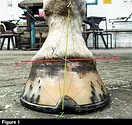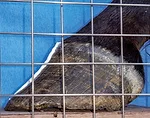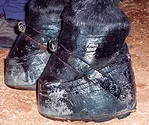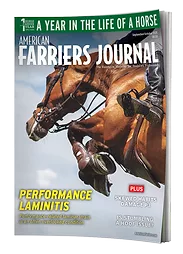Advertise Follow Us
American Farriers Journal

View Archived Issues
July/August 2018
Volume: 44
Edition: 5
American Farriers Journal is the “hands-on” magazine for professional farriers, equine veterinarians and horse care product and service buyers.
-
Table Of Contents
Table Of Contents
Always Consider What Affects the Hoof’s Shape
Dr. Simon Curtis reminds farriers that there are a multitude of factors that affect hoof shape — and should be considered when trimming and shoeing horsesRead MoreShoeing for a LivingWaging the Battle Against Distortion
After 30 years as a farrier, Pennsylvania shoer Doug Neilson finds his everyday work has evolved by becoming more straight-forward in his approachRead MoreWhat Eventing Riders Want Farriers to Know
Educating clients about mechanics of the distal limb and appropriate hoof care is critical to a successful relationshipRead MoreBeware of Equine Respiratory Disease Outbreaks
Recognizing and preventing the spread of illnesses help both horses and farriersRead MoreProtecting the Barefoot Horse’s Feet
Two studies from Western Kentucky University explore how hoof boots help barefoot horsesRead MoreStrategies for Correct Biomechanical Function
English farrier discusses techniques to help horses compensate for conformational issuesRead MoreTool Prep Makes Your Job Easier
Investing just a few minutes to maintain your forging tools will save you time and frustration at the anvilRead MoreHelp Your Backyard Horse Practice Thrive With These Business Tips
Farriers share their insights on establishing a successful clienteleRead MoreDeveloping the Eye for Detail
Learn to observe greater detail in the equine foot by breaking it down into smaller parts and sketching itRead MorePAST Act Could Spur More Changes
If enacted, legislation could eventually change shoeing for more than Tennessee Walkers, Spotted Saddle Horses and racking horsesRead MoreRemembering Lee Liles
Members of the farrier community reflect on Lee Liles’ dedication, knowledge and friendshipRead More“Grooving” Away Hoof Cracks
An electrically-heated iron makes it easy to burn grooves into the hoof wall to halt the progression of cracksRead MoreGenetic Condition Triggers Hoof Problems
The Connemara Pony may present Hoof Wall Separation Disease, which can be avoided through breeding and managed through proper farrieryRead MoreResearch Journal: July/August 2018
The information, ideas and opinions expressed are those of the author and do not necessarily represent those of the United States Department of Agriculture.Read More -
Featured Articles
Featured Articles
Shoeing for a LivingWaging the Battle Against Distortion
After 30 years as a farrier, Pennsylvania shoer Doug Neilson finds his everyday work has evolved by becoming more straight-forward in his approachRead MoreBeware of Equine Respiratory Disease Outbreaks
Recognizing and preventing the spread of illnesses help both horses and farriersRead MoreRemembering Lee Liles
Members of the farrier community reflect on Lee Liles’ dedication, knowledge and friendshipRead More - Digital Edition
-
Online Extras
Online Extras

























